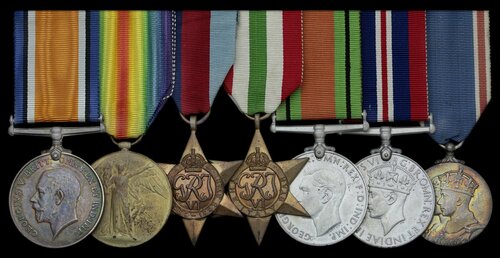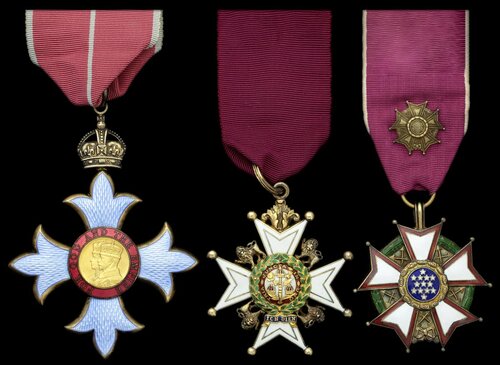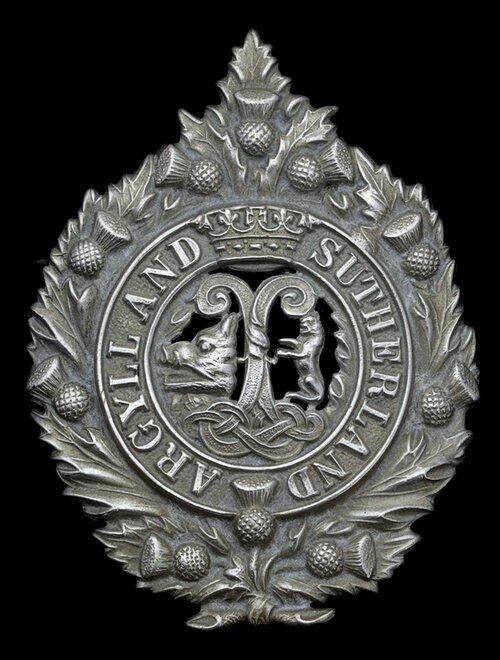Auction: 21003 - Orders, Decorations and Medals
Lot: 537
A good Second War C.B., C.B.E. group of 10 awarded to Air Vice Marshal B. McEntegart, Royal Air Force, who flew Sopwith Dolphins with No. '19' Squadron in the Great War later becoming involved in Experimental development in the run up to the Second World War and Air Officer Commanding, Air Headquarters Levant from 24 June 1943
The Most Honourable Order of the Bath, C.B., Military, neck Badge, silver-gilt and enamel; The Most Excellent Order of the British Empire, C.B.E., Military Division, 2nd Type, Commander's neck Badge, silver-gilt and enamel; British War and Victory Medals (Lieut. B. Mc Entegart. R.A.F.); 1939-45 Star; Italy Star; Defence and War Medals 1939-45; Coronation 1937; United States of America: Legion of Merit, breast badge, enamel, numbered to reverse '3618', the Orders in a Spink & Son brown card box, minor contact marks on Great War Pair, overall good very fine (10)
C.B. London Gazette 8 June 1944.
C.B.E. London Gazette 11 June 1942.
Legion of Merit London Gazette 1 January 1946.
Bernard Francis McEntegart was born on 12 November 1891. Upon the outbreak of the Great War McEntegart joined the 20th Battalion, Lancashire Fusiliers being commissioned 2nd Lieutenant on 6 October 1915. Joining the Royal Flying Corps on 9 February 1917 as a Flying Officer he was advanced Lieutenant on 1 July 1917. McEntegart joined the Royal Flying Corps in France on 11 April 1917 and began to fly as a Pilot on 15 April with No. 19 Squadron on the Western Front. With this Squadron he was flying alongside aces such as Albert Carter and John Leacroft - men with over 20 victories each. After a stint in Hospital (17-21 September) he returned to the home establishment, being promoted Temporary Captain on 1 March 1918. Returning to France as with the rank of Captain - later confirmed Flight Commander - with No. 19 Squadron on 1 May 1918, this unit was, at this time, flying escort duties having been re-equipped at the start of the year with the brand-new Sopwith Dolphin. Later transferring to command a flight in No. 60 Squadron, equipped with S.E.5's, with whom he remained for the rest of the War. McEntegart left the Squadron after the War joining Headquarters, No. 13 Wing on 14 February 1919.
Reposted a few days later with No. 29 Squadron on 21 February 1919 during the occupation of Germany, McEntegart was then briefly sent to No. 43 Squadron as a Pilot (6 August) before returning to the Home Establishment on 20 August. He was reemployed on 26 February 1920 with No. 6 Flying Training School as an instructor before joining No. 2 F.T.S. in the same role on 31 May 1920. Promoted Flight Lieutenant on 1 January 1922 he also attended an Instructor's Course at the Central Flying School during this period. Leaving No. 2 F.T.S. on 30 November 1922 he later joined No 4 F.T.S. which had recently opened in Abu Suweir, Egypt. After almost five years with this posting McEntegart was advanced Squadron Leader on 1 July 1928 and moved to RAF Halton as an Administrative Officer on 7 April 1927. Leaving this role he became Personal Assistant to the Chief of Air Staff from 2 October 1928 - 24 March 1930, being reassigned not long after the arrival of Sir John Salmond. After attending several courses (including a flying boat course at RAF Colshot) he returned to active flying as a Flight Commander with No 205 Squadron on 17 January 1931 based out of Singapore. Here he married Anne Patmore, the couple having their first and only child in 1932. He twice served as their commanding officer from 29 December 1932 - 2 February 1933 then again from 1 December - 5 December 1933.
Listed as Supernumary on 28 February 1934, McEntegart joined the Staff of the Joint Directorate of Research and Development on 21 June before switching to the research-focussed Royal Aircraft Establishment to which he was attached on 25 June. Advanced Wing Commander on 1 January 1935 he was made Officer Commanding the Experimental Section of the R.A.E. on 17 August 1937. Promoted Group Captain on 1 November 1938 in preparation for his new role as Commandant of the Aeroplane and Armament Experimental Establishment at RAF Martlesham Heath, which he took up on 25 November. With the outbreak of the Second World War the A. & A. E. E. was moved to RAF Boscombe Down on 20 September 1939: McEntegart remained in command, being advanced Temporary Air Commodore on 1 December 1940 and serving in this post until 24 June 1943 when he became Air Officer Commanding, Air Headquarters Levant. Confirmed in his rank on 1 December 1943 he was promoted Temporary Air Vice-Marshal that same day. The next year he was posted Air Officer Commanding, Headquarters Mediterranean Allied Air Forces on 27 January 1944. In the course of these duties he recieved a 'mention' on 14 June 1945 - however McEntegart's health was failing and on 2 July 1945 he was given a special appointment of Directorate-General of Personnel and retired on 9 November, retaining the rank of Vice Air-Marshal. He joined his wife in Britain, moving to a farm at Dunscore, Dumfries; in his absence she had become a dairy farmer to support the war effort, their son having been evacuated to Canada. McEntegart died on 25 September 1954; sold together with an Argyll and Sutherland Highlanders cap badge.
Subject to 20% VAT on Buyer’s Premium. For more information please view Terms and Conditions for Buyers.
Sold for
£3,000
Starting price
£800









